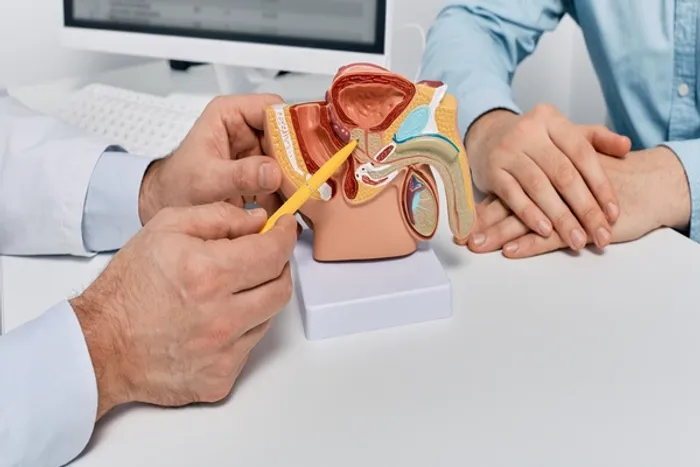Guide to Symptoms And Early Detection In Prostate Cancer
Know about the early detection of prostate cancer, why it's important, early signs, screening techniques, PSA results, guidelines, balancing benefits and harms and more.


Introduction
Prostate cancer is common, but it’s often silent in its early stages—precisely when it’s most treatable. That’s why early detection matters. If you’ve heard about the PSA blood test, digital rectal exam (DRE), or newer MRI-first approaches, you may be wondering what’s right for you. This guide translates the latest, authoritative advice into plain language for the general public seeking reliable health care guidance. We’ll cover symptoms to watch for, who’s at higher risk, how screening works, what test results mean, and what happens next if something looks abnormal. You’ll also see how leading guidelines recommend shared decision-making, allowing you to balance the benefits and potential harms of testing based on your personal values and risks. Whether you’re just starting to think about prostate cancer early detection or you’re deciding on a next step after an elevated PSA, this article offers practical pointers, examples, and a step-by-step plan. If symptoms persist beyond two weeks or you’re concerned about your risk, consider consulting a doctor online via Apollo 24|7 for personalised advice and next steps.
Why Early Detection Matters
Two more reasons early detection matters:
- Treatment precision has improved. Tools like multiparametric MRI (mpMRI) and MRI-targeted biopsies help identify clinically significant cancers and reduce unnecessary procedures.
- Newer risk-adapted protocols can reduce overdiagnosis. Instead of a one-size-fits-all approach, major guidelines encourage tailored screening based on age, family history, ancestry, genetic risk, and previous PSA levels.
Consult a Top Oncologist for Personalised Advice
Who Is at Risk? Personalising Your Screening Plan
Prostate cancer risk rises with age. Most cases occur after age 50, and the lifetime risk for men is roughly 1 in 8 in the United States. Some groups have a higher risk:
- Family history: A father or brother with prostate cancer, especially if diagnosed before 60, increases your risk. Multiple affected relatives raise it further.
- Ancestry: Men of African ancestry have a higher incidence and mortality from prostate cancer compared with other groups.
- Genetics: Inherited mutations such as BRCA1/2 or HOXB13 can significantly raise risk and are more common in families with multiple prostate, breast, ovarian, or pancreatic cancers.
Other factors may play a role: obesity and metabolic syndrome have been linked to a higher risk of aggressive disease; long-term inflammation of the prostate may contribute in some cases.
What this means for screening:
- Average risk: Many guidelines discuss a first PSA between ages 45–50, with shared decision-making about intervals.
- Higher risk: Consider earlier discussion and screening (often starting around 40–45) if you’re of African ancestry, have a strong family history, or carry a high-risk mutation.
- Older adults: If life expectancy is under 10 years, many guidelines suggest stopping routine screening.
Early Signs and Symptoms—What’s Typical and What’s Not
Most early prostate cancers don’t cause symptoms. That’s why screening is a separate topic from symptoms. When symptoms do occur, they often overlap with benign conditions like benign prostatic hyperplasia (BPH) or prostatitis.
Common, non-specific urinary symptoms:
- Frequent urination, especially at night (nocturia)
- Weak stream, hesitancy, or dribbling
- Urgency or incomplete emptying
These lower urinary tract symptoms (LUTS) are very common with ageing and typically not due to cancer. Still, new or bothersome symptoms deserve evaluation; sometimes the evaluation leads to a discussion about PSA and risk.
Red flags requiring prompt attention:
- Blood in urine (hematuria) or semen (hematospermia)
- Unexplained weight loss, fatigue
- New bone pain (hips, back, ribs), especially if persistent or worsening
- New erectile dysfunction without other explanations
Screening Tests, Old and New: PSA, DRE, and Beyond
- PSA blood test: Prostate-specific antigen (PSA) is a protein made by prostate tissue. Elevated PSA can occur with cancer—but also BPH, inflammation, or even recent ejaculation or cycling. That’s why a single elevated result usually leads to repeat testing before bigger steps.
- Digital rectal exam (DRE): A clinician gently examines the prostate through the rectum to feel for hard or irregular areas. DRE may detect abnormalities even when PSA is normal, though it’s less sensitive than PSA for early changes.
Newer tools that refine early detection:
- Risk calculators combine your age, PSA, family history, DRE, and other factors to estimate your chance of clinically significant cancer.
- Multiparametric MRI (mpMRI) can help visualise suspicious regions in the prostate. If MRI shows a concerning area, a targeted biopsy can sample precisely that spot.
- Biomarkers (e.g., per cent free PSA, PSA density, PHI, 4Kscore) can help decide who needs imaging or biopsy.
Pros and cons:
- Pros: Early detection of aggressive cancers; reassurance when tests are normal; more choices if cancer is found early.
- Cons: False positives can cause anxiety and lead to unnecessary biopsies; some cancers found are indolent (overdiagnosis), potentially leading to overtreatment [7].
Understanding PSA Results and Next Steps
Interpreting PSA is about context, not a single magic number.
- Typical thresholds: Historically, many clinicians considered 4.0 ng/mL as a cutoff. Now, age-adjusted thresholds and trends (PSA velocity) are often more informative [5][6].
- Free PSA: The ratio of free to total PSA. Lower free PSA can suggest higher risk of cancer in certain PSA ranges (e.g., 4–10 ng/mL).
- PSA density: PSA level divided by prostate volume (from imaging). Higher density can signal greater risk.
- PSA velocity: How quickly PSA rises over time. Rapid increases may warrant closer follow-up.
If your PSA is elevated:
- Repeat the test after addressing transient factors (e.g., treat infection, wait a few weeks) [5].
- Consider biomarkers or mpMRI to refine the need for biopsy [6][13].
- Discuss with a clinician who can interpret your PSA in light of age, family history, ancestry, and symptoms.
Preparing for retesting:
- Avoid ejaculation and vigorous cycling for 48 hours.
- Reschedule if you have a urinary tract infection or acute prostatitis.
- Maintain consistency: test at the same lab and time of day if possible.
Confirming Diagnosis: MRI, Targeted Biopsy, and Grading
Multiparametric MRI (mpMRI) has changed the game. It can identify suspicious lesions and guide targeted biopsies, improving detection of clinically significant cancers while reducing unnecessary biopsies [13]. The PRECISION trial (NEJM 2018) showed that MRI-targeted biopsy detected more significant cancers and fewer insignificant ones compared with standard systematic biopsy alone.
Biopsy approaches:
- MRI-targeted biopsy: Focuses on MRI-identified lesions.
- Systematic biopsy: Samples multiple standard zones; sometimes used with targeted biopsy for completeness.
Grading and significance:
Pathologists assign a Gleason score, now reported as Grade Groups (1–5), which helps predict behaviour and guide treatment decisions. Grade Group 1 (Gleason 3+3) is often considered low risk, while higher groups indicate greater aggressiveness.
Active surveillance:
For low-risk prostate cancer, many men can safely choose active surveillance—regular PSA tests, repeat imaging/biopsies as needed—avoiding or delaying treatment side effects while staying vigilant.
Balancing Benefits and Harms: Guidelines and Shared Decisions
The balancing benefits and harms include:
- Major guidelines converge on one message: Decide together.
- USPSTF: For men 55–69, PSA-based screening is an individual decision after discussing benefits and harms; routine screening is not recommended for men 70+ [7].
- AUA: Supports PSA-based screening with shared decision-making, offering earlier discussion for higher-risk groups and considering discontinuation when life expectancy is <10–15 years [5].
- NCCN: Emphasises risk-adapted screening (baseline PSA, mpMRI, biomarkers) to reduce unnecessary biopsies and overtreatment.
Potential benefits:
Lower risk of metastatic disease and prostate cancer death in some screened populations.
Potential harms:
False positives, anxiety, biopsy complications (bleeding, infection), and overdiagnosis (finding indolent cancers that may never cause harm).
Decision aids can clarify personal values. Some men prioritise catching any cancer early; others prioritise avoiding false alarms and invasive tests. Discuss your preferences, risk factors, and overall health with your clinician. If your condition does not improve after trying these methods, book a physical visit to a doctor with Apollo24|7.
Your Practical Plan: Timing, Lifestyle, and Monitoring
When to start:
- Average risk: Consider baseline PSA at 45–50 with shared decision-making [5][6].
- Higher risk (African ancestry, strong family history, BRCA/HOXB13): Consider starting around 40–45.
How often:
- If PSA is low and stable, intervals of every 2–4 years may be reasonable (tailored by guideline and individual factors).
- If PSA is elevated or rising, discuss shorter intervals, biomarkers, or mpMRI.
When to stop:
Many guidelines suggest stopping routine screening when life expectancy is under 10 years.
Lifestyle for risk reduction and overall health:
- Heart-healthy diet (vegetables, fruits, whole grains, healthy fats), manage weight, stay physically active. Cardiometabolic health is linked to better cancer outcomes and quality of life.
- Don’t smoke; moderate alcohol if you drink.
- Maintain regular primary care visits to monitor blood pressure, glucose, and cholesterol.
Monitoring basics:
- Keep a personal record of PSA values, dates, and any relevant events (infections, procedures).
- Use the same lab when possible to minimise variability.
- Ask about risk calculators to make sense of your numbers.
Getting Care Made Easier (Telehealth, At-Home Tests, Apollo 24|7)
Let us see when to seek doctor's help:
When to seek telehealth:
- You have questions about whether to start screening.
- You want help interpreting a PSA result.
- You’re deciding between retesting, biomarkers, MRI, or referral.
When to go in-person:
- Abnormal DRE or persistently elevated/rising PSA.
- New red-flag symptoms (blood in urine, bone pain, weight loss).
- Planning imaging or biopsy.
Making testing smoother:
- Ask about home sample collection for PSA, especially if you’re monitoring a trend. Apollo24|7 offers convenient home collection for PSA and other labs, with reminders and result tracking.
- Prepare for PSA by avoiding ejaculation or vigorous cycling for 48 hours and rescheduling if you have a urinary infection.
Conclusion
Prostate cancer early detection is not a one-size-fits-all decision—and that’s a good thing. Tailoring screening to your personal risk, age, and preferences helps you capture the life-saving benefits while minimising false alarms and unnecessary procedures. Start with a baseline PSA in your 40s if appropriate (earlier if you’re higher risk), and interpret results in context: family history, ancestry, free PSA, density, velocity, and, when needed, mpMRI. If you’ve had urinary changes, are unsure when to start screening, or you’re interpreting a PSA result, speak to a doctor online with Apollo24|7. If you need testing, Apollo 24|7 offers convenient home collection for PSA and routine labs, so you can track trends over time. Early detection starts with a conversation—make yours today, and take a confident step toward protecting your health.
Consult a Top Oncologist for Personalised Advice
Consult a Top Oncologist for Personalised Advice

Dr Gowshikk Rajkumar
Oncologist
10 Years • MBBS, DMRT, DNB in Radiation oncology
Bengaluru
Apollo Clinic, JP nagar, Bengaluru

Dr.sanchayan Mandal
Medical Oncologist
17 Years • MBBS, DrNB( MEDICAL ONCOLOGY), DNB (RADIOTHERAPY),ECMO. PDCR. ASCO
Kolkata
Dr. Sanchayan Mandal Oncology Clinic, Kolkata

Dr. Sanchayan Mandal
Medical Oncologist
17 Years • MBBS, DNB Raditherapy, DrNB Medical Oncology
East Midnapore
VIVEKANANDA SEBA SADAN, East Midnapore

Dr. Gopal Kumar
Head, Neck and Thyroid Cancer Surgeon
15 Years • MBBS, MS , FARHNS ( Seoul, South Korea ), FGOLF ( MSKCC, New York )
Delhi
Apollo Hospitals Indraprastha, Delhi
(25+ Patients)

Dr. Rupam Manna
Radiation Specialist Oncologist
4 Years • MBBS MD(RADIO THERAPY)
Barasat
Diab-Eat-Ease, Barasat
Consult a Top Oncologist for Personalised Advice

Dr Gowshikk Rajkumar
Oncologist
10 Years • MBBS, DMRT, DNB in Radiation oncology
Bengaluru
Apollo Clinic, JP nagar, Bengaluru

Dr.sanchayan Mandal
Medical Oncologist
17 Years • MBBS, DrNB( MEDICAL ONCOLOGY), DNB (RADIOTHERAPY),ECMO. PDCR. ASCO
Kolkata
Dr. Sanchayan Mandal Oncology Clinic, Kolkata

Dr. Sanchayan Mandal
Medical Oncologist
17 Years • MBBS, DNB Raditherapy, DrNB Medical Oncology
East Midnapore
VIVEKANANDA SEBA SADAN, East Midnapore

Dr. Gopal Kumar
Head, Neck and Thyroid Cancer Surgeon
15 Years • MBBS, MS , FARHNS ( Seoul, South Korea ), FGOLF ( MSKCC, New York )
Delhi
Apollo Hospitals Indraprastha, Delhi
(25+ Patients)

Dr. Rupam Manna
Radiation Specialist Oncologist
4 Years • MBBS MD(RADIO THERAPY)
Barasat
Diab-Eat-Ease, Barasat
More articles from Prostate cancer
Frequently Asked Questions
What are the early symptoms of prostate cancer?
Most early prostate cancers cause no symptoms. Urinary changes (frequency, weak stream) are common with ageing and usually not due to cancer. Screening can detect cancer before symptoms appear. If symptoms persist, consult a doctor online with Apollo24|7.
When should I start prostate cancer screening?
Average-risk men often discuss baseline PSA at 45–50. Higher-risk men (African ancestry, strong family history, BRCA) may start around 40–45. Decisions should be individualised using shared decision-making.
Is the PSA test reliable?
PSA is a helpful first step, but not perfect. Levels can rise for non-cancer reasons. Free PSA, density, velocity, biomarkers, and mpMRI help refine risk before biopsy.
What happens if my PSA is high?
Your clinician may repeat PSA, check biomarkers, use a risk calculator, or order an mpMRI. If risk remains elevated, an MRI-targeted biopsy may be recommended. Keep your results and track trends.
Can I avoid overtreatment if I have low-risk cancer?
Yes. Many men with Grade Group 1 (low-risk) choose active surveillance—regular monitoring with PSA, imaging, and occasional biopsies—delaying or avoiding treatment side effects while staying safe.




